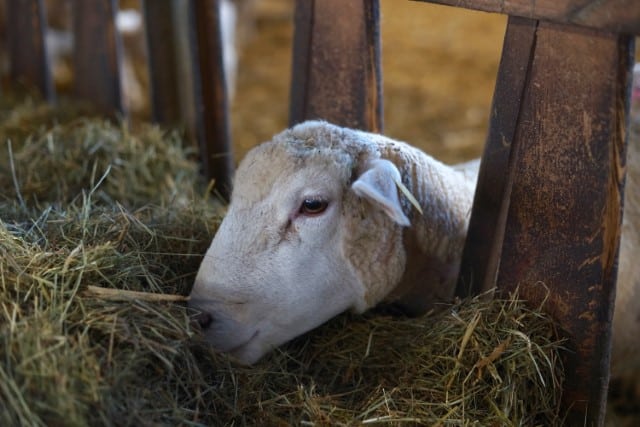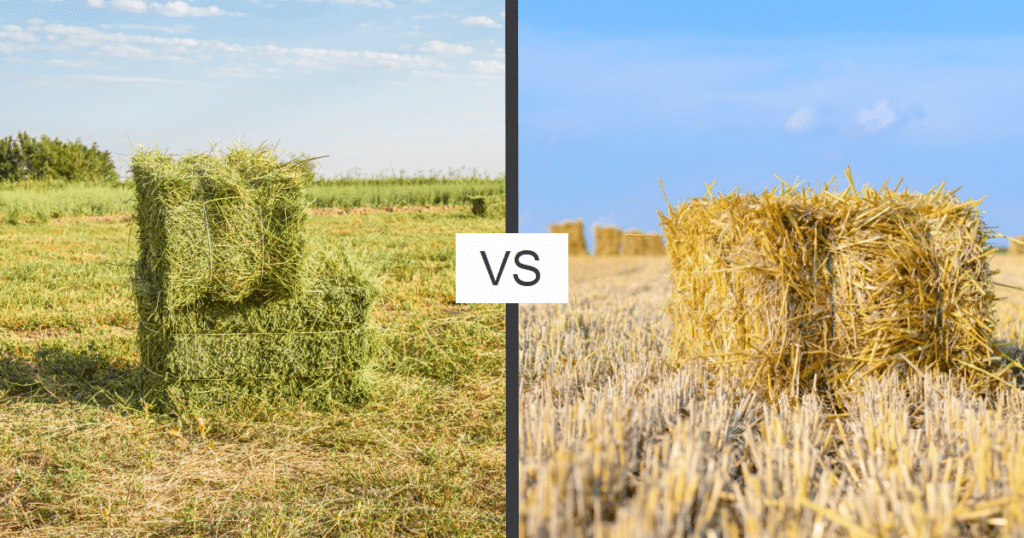If you’re not a farmer or don’t live in a rural area, you probably use the terms “hay” and “straw” interchangeably. I know I hear people misuse these words all the time. Today I’ll compare hay vs straw so you understand the differences and can quickly tell one from the other. Let’s get started!
The Difference Between Hay and Straw
Hay is dry grass that is fed to sheep and other livestock, and straw is used for bedding material on farms (the animals don’t eat it).
- Straw typically has a coarse texture and is golden in color when baled.
- Hay has a softer, leafy texture. Bales of hay tend to be green.
In this article, I will talk about the plants used to produce both materials. I will also talk about why hay is food for sheep and straw is used for sheep bedding.
Understanding the Difference Between Hay and Straw
Let’s dig a little deeper and more fully compare straw vs hay.
Hay
Hay is comprised of grass and legumes. This includes grasses or clover, as well as plants such as alfalfa. Examples of grasses that are used include oat, fescue, and Bermuda.

Hay is green in color and there are particular kinds of hay that are fed to specific animals. The kind of hay that is fed to an animal depends on the specific animal’s nutritional needs.
For example, a working horse needs a lot of protein and carbohydrates. If you have working horses, you’ll need hay with high protein and carbohydrate content.
With hay, the producer needs to harvest plants when they’re still alive. In fact, they are often harvested before the point where the seed matures.
After that, the hay needs to be dried. One of the most important facts of hay production is that the moisture content must be extremely low.
If a hay bale is too moist, it will quickly become moldy. When this happens, it cannot be used as feed.
Another problem with too much moisture in bales is the fact that it can make the hay more flammable. This is because moisture spurs on decomposition, and the material generated by decomposition is more likely to catch fire than completely dry hay.
Hay is an important feed for animals such as sheep, horses, goats, and cows, especially when they don’t have enough pasture to graze on.
If you have animals and need to buy them hay, be very careful not to accidentally buy straw instead. Bales of hay and straw look very similar, and you might have difficulty telling them apart if you’re an inexperienced farmer.
Straw
Straw comes from the grain (wheat) harvest, of which it is a by-product. It is golden or yellow in color.
It cannot be used for livestock feed. That is because straw offers very little nutrition.
This is especially the case with dry straw. After the grain harvest, hollow stocks are cut and formed for the straw production process.

Straw is most commonly used as bedding. That is because of how fluffy and light it is, and the way that it can retain warmth.
You can also use straw for mulch, stopping soil’s top layer from getting excessively dry and maintaining moisture in the soil.
Straw is able to compost over a period of time. It is also able to crush weeds.
The stems that are left behind with the harvesting of grains such as wheat and barley are made into straw. As there is very little nutrition in stems, straw has limited nutrition to offer animals.
You can use straw as bedding for your livestock animals. It is also used for other purposes, such as basket-making and other crafts.
Today, straw is being used as a fuel source in bioenergy.
Hay vs Straw Comparison Table
| Hay | Straw |
|---|---|
| Hay is made from grass and legumes. It often includes grasses or clover, as well as plants such as alfalfa. Examples of grasses that are used include oat, fescue, and Bermuda. | Straw is a by-product of grain (usually wheat). The stalks (which hold very little nutrition and therefore aren’t of use elsewhere) of the wheat are dried and made into straw. |
| Hay is used for animal feed. It contains nutrition that livestock animals need, and it’s especially important when livestock have little or no access to pasture. The type of hay you should feed to your animals depends on the animal and its nutritional needs. | Straw is used for purposes such as animal bedding. Straw contains very little nutrition and therefore isn’t used for feed. |
| Hay is green in color. | Straw is yellow or golden in color. |
What Kinds of Hay Should You Feed to Sheep?
You’ve got to consider your specific animals and the time of year when deciding on the best hay to feed your sheep.
In general, the best hay you can give your sheep is the quality that will give the animals the nutrients they need for the best possible price.
Of course, you need to think about palatability, too.

While legume hay generally offers better nutrition than grass hay, this isn’t always the case. Quality is another crucial factor.
For example, high quality grass hay will usually be nutritionally superior to low or medium quality legume hay.
When it comes to ewes in maintenance or in early to middle periods of gestation, a grass hay of average quality will usually be good enough.
Grass hay almost always has enough nutrition for wethers and mature rams.
For ewes in late gestation, you should go with a mixed-grass-legume hay. This is because they need a higher degree of minerals and calcium.
For ewes that have delivered their lambs and are in lactation, it’s best to use high-quality legume hays, such as alfalfa hay. These animals need the extra calcium and protein.
There’s a Big Difference Between Hay and Straw!
As a sheep farmer, it’s absolutely essential that you know the difference between hay and straw.
When you go to buy these goods, examine the bales carefully and ask questions to make sure you are getting exactly what you need.
Both hay and straw are harvested and stored in bales, so that is something to keep in mind. You don’t want to waste vital financial resources on the wrong products (or look silly by using the wrong term).

